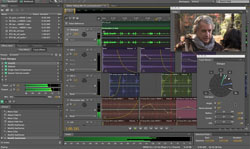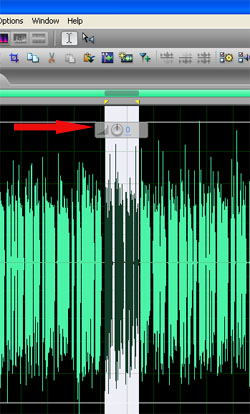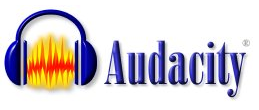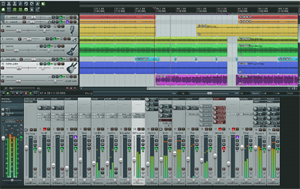EQ (equalization) is a very useful concept and tool in audio recording. If you want to brush up on what it is all about, check out our article here: What is Equalization, Usually Called EQ? When first learning how to use EQ, it can be confusing to understand what settings to use for what sounds. It is often very handy to have a a guide that tells you where to start for common sounds, like voices and tons of different instruments. The entry at the below link will give you such a guide. Not only is this a great reference, but it can help you start to learn where on the frequency scale these sounds live, in general, giving you a foundation for understanding how to shape your sounds for the best possible audio.
http://www.audiorecording.me/complete-eq-settings-to-start-when-doing-audio-mixing.html
audio editing
Adobe Audition – More Than Just an Audio Editor

Adobe Audition is a full-featured audio recording and editing software program. What I mean by “full-featured” is that not only does it allow you to record and edit audio, it also has a multi-track screen that allows you to mix audio on different tracks as well as add midi virtual instruments, etc.
I started using Adobe Audition when it was a different program called Cool Edit Pro back int he 90s. Adobe purchased it from the developers, Syntrillium, in 2003 and renamed it Audition. There were 3 versions of AA until 2011, when Adobe made it part of their suite of programs called Creative Suite 5.5, or CS 5.5 for short. The latest version is referred to by some as Adobe Audition 4. Now in 2017, it’s part of the Creative Cloud as well.
As a DAW
A digital audio workstation, or DAW, is the term usually applied to software that allows you to record and mix multiple tracks of audio, usually together with MIDI and/or video tracks as well. When Cool Edit was developed, it was intended, as the name implies, as an audio editor. that means that you open a single audio file (mono or stereo) and make changes to that file. When you’re done, you end up with a different file than the one you started with. It’s basically the same thing as editing a Word document. If you open a .doc file and make changes to the the spelling, grammar, layout, etc., you’d just edited that file, and when you save that version it’ll be different from the original.
Somewhere along the line, though, Syntrillium decided to add multi-track functionality as well. It worked pretty well for basic stuff. They had a toggle button to allow you to switch between the multi-track and editing screens. As version progressed, they added more and more to the multi-track part of the program. But things just got kind of complicated and the midi stuff was not great. So when Reaper (by Cockos) came out in about 2006, I jumped on it as my primary DAW and stopped using the multi-track piece of Audition, though I still use it for editing and mastering.
As an Editor
There is a rule-of-thumb I like to use for products and companies that also works well for food and restaurants. I ask myself “what is the company’s/restaurant’s specialty?” If I’m at a seafood place I tend not to order the steak. Once I ordered a Boston Cream Pie for dessert at Marie Calendars and didn’t like it. When I told my wife, she said “well, Boston Cream Pie is not pie. It’s cake! You ordered cake from a pie shop; what did you expect?” There is a point to this, I promise.
If you ask “what was the specialty of Cool Edit Pro?” As the name implies (again), the answer is “audio editing.” So Audition is basically an editor with multi-track functions added on.
Now if you ask what the specialty of Reaper is, the answer is a big fat “DAW.” It is designed from the ground up to be a multi-track recording program. Even better, it was designed to be a streamlined program without all the code bloat you get from competitors. That being the case, Audition was relegated to the job of editor in my studio.

But this is an article about Audition, so what makes it a good editor? For me it’s about workflow and excellent quality effects. I have a different mind-set about editing than I do about working in multi-track mode. Ironically it was probably Syntrillium/Adobe that caused this in me. Either way, when I finish recording and mixing several tracks together and the final product is ready to be mixed down/rendered into one file, my brain switches to edit mode.
I open the file rendered from Reaper in Audition and set to work. There are several outcomes I’m looking to achieve in the editor, such as eliminate residual noise, tame p-pops and other vocal extremes (such as little clicking sounds associated with saliva in the mouth, etc.), and overall average volume of the audio. The tool I love the most in Audition is the Gain Control tool. See the picture on the right. What this does is allows you to quickly and immediately raise or lower the gain (just think “volume”) on ONLY what is selected. Everything else remains as is. Of course sometimes You WANT to select and adjust all your audio and so the tool affects everything. But it is such a time saver. Before this tool was available, I had to select some audio and enter a number corresponding to how much I wanted to raise or lower the gain, hit OK and use trial-and-error until I got it right. With this tool, you can see immediately how the audio waveform will be changed while you hold down the mouse button and drag. You can make adjustments while still holding down the button, and when you have it where you want it, you just release the mouse button and the change is made. Have I mentioned that I LOVE this?
In addition to the gain control editing, I also like to add or remove silent areas. Sometimes, especially with dialog, you want to increase or decrease the time between phrases. This is fast and easy with Audition. I also mentioned editing p-pops. For that I use the “Favorites” toolbar and created an EQ curve that cuts out a bunch of the bass (low) frequencies. All I have to do is select the part of the audio saying the “P” sound, click the “P-pop” control that I created on my Favorites toolbar, and it’s done and on to the next thing.
Once everything is timed and sounding just how I want it, I “normalize” the result, which just means that the gain of the entire audio file is raised by the amount it takes for the loudest single sound to hit max volume. This ensures that the audio is as loud as it can be without clipping and causing distortion.
So that’s really it in a nutshell. Adobe Audition is what I use just for editing, but many folks use it as their all-in-one audio solution. As ever, these decisions are highly personal and depend on how you like to work. My own recommendation nowadays is to start with just Reaper. With its own capabilities you may never need an external editor at all. If you need to add an editor, Adobe Audition is a great choice. Check it out on amazon HERE.
Cheers!
Audacity – The Free Audio Recording Software
 Audacity is a bit of a breakthrough in audio software for several reasons. The first of those reasons is that it is free. The second reason is also that it is free. Ok, seriously this time. The third reason is that this software is capable of doing some pretty sophisticated things, especially for the price, which I believe I mentioned once or twice.
Audacity is a bit of a breakthrough in audio software for several reasons. The first of those reasons is that it is free. The second reason is also that it is free. Ok, seriously this time. The third reason is that this software is capable of doing some pretty sophisticated things, especially for the price, which I believe I mentioned once or twice.
So you probably want to know all about it now right? Well I can certainly give you a summary of Audacity, along with the pros and cons. Let’s dive in.
The Good
Like I said, Audacity is pretty amazing for the price. Depending on what kind of recording you are (or plan on) doing, you can get professional level results with this software. In a nutshell, Audacity is an audio recorder and editor that you can use on multiple platforms, including Windows, Mac and GNU/Linux. It is a 32-bit application.
For recording, it is great for capturing one thing, on one track, at a time. This is good news for most folks doing home recording, especially podcasters and other voice over type folks. Just connect a microphone into your computer and hit the big, fat red “record” button and start talking (or singing, or playing an instrument, or… you get the idea). When you’re done, hit the big “Stop” button and you’re done.
If that was all you needed to record (just the one track), and you’re happy with the way it sounds, all you need to do now is “export” it, which saves your audio as a wav file. You can also choose to save your audio as an Ogg Vorbis file, which is a data-compressed file comparable to mp3, which means it takes up less space for internet use, etc. It is also open-source and un-patented, unlike mp3. You can also export your audio as an mp3, but you have to install the the Lame Encoder first. Instructions for doing that are on the Audacity web site. It’s pretty easy.
If you aren’t happy with the audio you just recorded on the one track, you can use any of the dozens of editing tools that are built right in, such as noise reduction, EQ, compression, fading, etc. You can also add effects from the built-in selection, such as echo, delay, phaser, reverser, or play with the time and pitch tools. Those are just to name a few. The latest version of Audacity (1.2.6 or the beta version 1.3.14 as of December 2011) can utilize VST plugins as well. This means you can add effects and editing tools from 3rd party programs as plugins. With 1.2.6 you need to install something called the VST Enabler in order to use VST plugins. The beta version has support for VST built in.
If you want to add tracks to play along with your first track, you can also do that while listening to the first one play back. This, in effect, turns Audacity into a multi-track recorder as well. You can use this function to add background music behind your voice. Or you can even sing harmony with yourself (or whoever), record other instruments to make yourself a one-person band, etc. When you’re done adding these additional tracks, just mix the volumes together and maybe pan the tracks so that some of the sounds sound like they’re coming from the left, some from the right, and some from the middle, and then export your production.
The Maybe Not-So-Good
I finished up the “The Good” section talking about using Audacity for multi-track recording. One thing that is a problem when doing this is that there are synchronization issues between the tracks. I find I have to manually slide the audio on a track left or right to get it to sync up with the audio in the track above it, which is a bit wonky.
Another huge drawback (though remember, we ARE talking about free and very basic software here) is that you can’t do anything with MIDI or virtual instruments. So for musicians, this is probably not the best software to use if you want to produce professional music tracks.
The quality of the built-in effects is also not the highest. The noise-reduction tool is one example of this. I found that it was very difficult to do much noise reduction without the resulting audio having the tell-tale “under-water” sound to it. Compared to the audio restoration tools in programs like Adobe Audition, it is definitely not great.
Another thing that I find to be a problem with Audacity is that it just tends to be very complex. I’ve heard folks say that you need to have an engineering degree to figure it out. I don’t know if that’s true. There are certainly lots of tutorials out there. Heck, the entire first module of our home recording course – The Newbies Guide to Audio Recording Awesomeness 1 uses Audacity exclusively, mainly because we wanted to start folks out with a budget of $5.00 or less. But without some good guidance like that, I’d have to say the Audacity is not very user-friendly, especially to folks who are just beginners in the audio recording world.
There you have your down-and-dirty overview of Audacity, the free audio recording software that can do some amazing things, especially for the price.
Cheers!
Ken
Your Home Studio and Reaper – No Additional Audio Editor Needed

I’ve been saying that for your home studio, with Reaper software you also need an audio editing software program. It turns out that for most people in most situations, this is simply untrue. I know, crazy right? I’ve been giving out advice that may have been wrong. Gasp. For me, sadly, I think there is no going back; at least not easily. I started many moons ago using a program called Cool Edit Pro (now Adobe Audition), which had two “views” that you could toggle between; one for multitrack use and mixing, and one for audio file editing. When I was working in multitrack view and wanted to edit a file (which actually changes the underlying wave file in a process called “destructive editing”), I would click on the View toggle and presto! I was in the editing view. I worked like this for years.
Part of the reason I worked that way was that my computer was feeble, which is to say, normal. In order to treat a track in multitrack view with effects that could have done some of the same things that I was doing in the edit screen, I would have been using “non-destructive” editing. These treatments, in the form of effect plug-ins, didn’t actually do anything to the underlying wave file in the track. The effect would just plug into the track and affect whatever audio happened to be on that track. This kind of non-destructive editing eats up massive amounts of computer horsepower in a hurry, especially if you have several tracks and several effects running. It didn’t take much at all for my computer to simply raise the white flag and lie down in exhaustion. Destructive editing, especially if I saved a back-up of the original file, was the way to go for non-specialized computers.
Eventually, a program called Reaper came on the scene and had, as one of its biggest benefits, a streamlined architecture that ate up fewer computer resources than its fellows. I jumped on-board immediately and started doing a lot of my formerly-destructive editing tasks in Reaper (like compression, EQ and reverb) with no ill effects on my computer. But there were still things I did in Adobe Audition, mostly our of habit. Those were things like p-pop elimination, noise reduction, and final mix mastering. I still do that today.
But you almost certainly don’t have to use an external editor at all. I’ve been challenging my assumptions and habits and it turns out that for most readers of Home Brew Audio (we cater to recordists of voice over and musician alike here). I’m going to be doing some more checking up on this, just to fully convince myself, especially in the noise reduction arena. I’ll let you know what I find out. But if you’ve been confused in the past by my assertion that if you use Reaper, you’ll also need an external audio editor, please know that I have reversed (mostly) my thinking on that score.
Go forth and record AND edit with Reaper!
Multiple Mics and The Ravages of Time
So much of capturing sound in our home studio recording efforts comes down to time. We get close to the microphone perhaps to help reduce room sound, trying to win the race against the reflected versions of our voices that have bounced off the walls.
Maybe we make a copy in our multi-track software of something we recorded with a single microphone – intending to delay one version by 30 milliseconds so we can pan both copies left and right to create fake stereo. This is only possible by manipulating time-related stuff, the relative positions of our two tracks to each other with respect to time.
All too often, copies of sounds we want to record enter our recordings without our permission, blending unpleasantly with their fellows, rendering the effects of college wave mechanics and bringing terms like constructive- and destructive-interference back into our brains. Amends can be made by moving stuff around, filtering, raising or lowering volumes at targeted frequencies, or any number of other remedies.
Such is the subject of the article below. Use more than one microphone to record something and you risk any or all of the wave-mechanic-y problematic symptoms on a heretofore unheard of level.
http://www.homerecordingshow.com/2011/11/show-141-multi-mic-time-aligning-and-aes-convention-recap/?utm_source=feedburner&utm_medium=feed&utm_campaign=Feed%3A+homerecordingshow+%28The+Home+Recording+Show%29